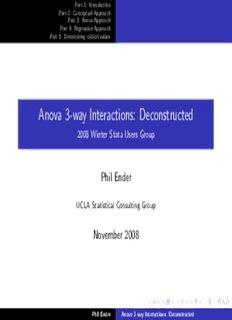
Anova 3-way Interactions: Deconstructed - 2008 Winter Stata Users PDF
Preview Anova 3-way Interactions: Deconstructed - 2008 Winter Stata Users
Part1:Introduction Part2:ConceptualApproach Part3:AnovaApproach Part4:RegressionApproach Part5:Determiningcriticalvalues Anova 3-way Interactions: Deconstructed 2008 Winter Stata Users Group Phil Ender UCLAStatisticalConsultingGroup November 2008 PhilEnder Anova3-wayInteractions:Deconstructed Part1:Introduction Part2:ConceptualApproach Part3:AnovaApproach Part4:RegressionApproach Part5:Determiningcriticalvalues Three approaches Explaining 2-way interactions is pretty routine but 3-way interactions can be intimidating to some people. This presentation will look at three approaches to understanding a 3-way interaction: (cid:73) 1 Conceptual Approach (cid:73) 2 Anova Approach (cid:73) 3 Regression Approach PhilEnder Anova3-wayInteractions:Deconstructed Part1:Introduction Part2:ConceptualApproach Part3:AnovaApproach Part4:RegressionApproach Part5:Determiningcriticalvalues Meet the data . use http://www.ats.ucla.edu/stat/stata/faq/threeway, clear This is a synthetic dataset for a 2x2x3 factorial anova design with 2 observation per cell. The data were constructed to have different two-way interactions for each level of A. PhilEnder Anova3-wayInteractions:Deconstructed Part1:Introduction Part2:ConceptualApproach Part3:AnovaApproach Part4:RegressionApproach Part5:Determiningcriticalvalues Anova table . anova y a b c a*b a*c b*c a*b*c Source | Partial SS df MS F Prob > F ----------+---------------------------------------------------- Model | 497.833333 11 45.2575758 33.94 0.0000 a | 150 1 150 112.50 0.0000 b | .666666667 1 .666666667 0.50 0.4930 c | 127.583333 2 63.7916667 47.84 0.0000 a*b | 160.166667 1 160.166667 120.13 0.0000 a*c | 18.25 2 9.125 6.84 0.0104 b*c | 22.5833333 2 11.2916667 8.47 0.0051 a*b*c | 18.5833333 2 9.29166667 6.97 0.0098 | Residual | 16 12 1.33333333 -----------+---------------------------------------------------- Total | 513.833333 23 22.3405797 PhilEnder Anova3-wayInteractions:Deconstructed Part1:Introduction Part2:ConceptualApproach Part3:AnovaApproach Part4:RegressionApproach Part5:Determiningcriticalvalues b*c means plot at a1 – possible interaction PhilEnder Anova3-wayInteractions:Deconstructed Part1:Introduction Part2:ConceptualApproach Part3:AnovaApproach Part4:RegressionApproach Part5:Determiningcriticalvalues b*c means plot at a2 – unlikely interaction PhilEnder Anova3-wayInteractions:Deconstructed Part1:Introduction Part2:ConceptualApproach Part3:AnovaApproach Part4:RegressionApproach Part5:Determiningcriticalvalues Conceptual Approach PhilEnder Anova3-wayInteractions:Deconstructed Part1:Introduction Part2:ConceptualApproach Part3:AnovaApproach Part4:RegressionApproach Part5:Determiningcriticalvalues About the conceptual approach Basically, this approach involves running separate anovas on subsets of the original model and manually computing the correct F-ratio using the MS residual from the original 3-factor model. You will need to save the MS residual value from the original anova model. MSresidual = 1.333333333 PhilEnder Anova3-wayInteractions:Deconstructed Part1:Introduction Part2:ConceptualApproach Part3:AnovaApproach Part4:RegressionApproach Part5:Determiningcriticalvalues b*c at a1 Run 2-way anova at a1 . anova y b c b*c if a==1 Source | Partial SS df MS F Prob > F -----------+---------------------------------------------------- b | 70.0833333 1 70.0833333 56.07 0.0003 c | 24.6666667 2 12.3333333 9.87 0.0127 b*c | 40.6666667 2 20.3333333 16.27 0.0038 | Residual | 7.5 6 1.25 -----------+---------------------------------------------------- Total | 142.916667 11 12.9924242 F-ratio for b*c interaction does not use correct error term. PhilEnder Anova3-wayInteractions:Deconstructed Part1:Introduction Part2:ConceptualApproach Part3:AnovaApproach Part4:RegressionApproach Part5:Determiningcriticalvalues b*c at a1 (cont) Manually compute correct F-ratio for b*c interaction. F(a*b at a1) = 20.33333333/1.33333333 = 15.25 PhilEnder Anova3-wayInteractions:Deconstructed
Description: